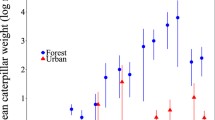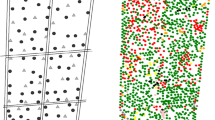Abstract
Calcium is an essential micronutrient for birds during egg formation and for skeletal development in nestlings. Habitat level studies suggest that birds breeding in low-calcium areas may be limited in the size or number of eggs they lay and in the quality of their nestlings. However, as birds forage non-randomly and may travel considerable distances to acquire calcium, describing different breeding environments in terms of their calcium availability is problematic. Here we explore the spatial relationships between 300-fold variation in soil calcium and the life-history traits of ca. 6,000 pairs of great tits breeding in a single continuous woodland over 41 years. Controlling for other habitat differences, we found strong positive associations between soil calcium, clutch size and recruitment at spatial scales of over 300 m from each nestbox, suggesting that females may have been travelling inter-territorially to acquire calcium during egg formation. Soil calcium near each nestbox (mean distance = 58 m) was a strong positive predictor of mean fledgling mass, suggesting that local calcium was more important during nestling stages. We found no effect of soil calcium on lay-date or egg mass. This study is the first to provide evidence that small woodland passerines are limited by calcium availability at several different spatial scales. However, experimental work is necessary to test the causality of these spatial patterns.




Similar content being viewed by others
References
Bidwell MT, Dawson RD (2005) Calcium availability limits reproductive output of tree swallows (Tachycineta bicolor) in a nonacidified landscape. Auk 122:246–254
Blancher PJ, McNicol DK (1991) Tree swallow diet in relation to wetland acidity. Can J Zool 69:2629–2637
Burnham KP, Anderson DR (1998) Model selection and inference: a practical information-theoretic approach. Springer, New York
Carey C (1996) Female reproductive energetics. In: Carey C (ed) Avian energetics and nutritional ecology. Chapman & Hall, New York, pp 324–374
Clunies K, Emslie J, Leeson S (1992) Effect of dietary calcium level on medullary bone calcium reserves and shell weight of leghorn hens. Poult Sci 71:1348–1356
Creutz G (1953) Schnecken als Nahrung von Singvogeln. Vogelwelt 74:52–54
Dingemanse NJ, Both C, van Noordwijk AJ, Rutten AL, Drent PJ (2003) Natal dispersal and personalities in great tits (Parus major). Proc R Soc Lond Ser B 270:741–747
Dawkins HC, Field DRB (1978) C.F.I. Occasional Paper No. 1. A long-term suveillance system for British woodland vegetation. Commonwealth Forestry Institute, University of Oxford, Oxford
Dawson RD, Bidwell MT (2005) Dietary calcium limits size and growth of nestling tree swallows Tachycineta bicolor in a non-acidified landscape. J Avian Biol 36:127–134
Farmer AM (1995) Soil chemistry change in a lowland English deciduous woodland. Water Air Soil Pollut 85:677–682
Garant D, Kruuk LEB, McCleery RH, Sheldon BC (2004) Evolution in a changing environment: a case study with great tit fledging mass. Am Nat 164:E115–E129
Garant D, Kruuk LEB, Wilkin TA, McCleery RH, Sheldon BC (2005) Evolution driven by differential dispersal within a wild bird population. Nature 433:60–65
Garant D, Kruuk LEB, McCleery RH, Sheldon BC (2007) The effects of environmental heterogeneity on multivariate selection on reproductive traits in female great tits. Evolution 61:1546–1559
Gibson CWD (1988) The distribution of ancient woodland plant species among areas of different history in Wytham Woods, Oxfordshire. In: Kirky KJ, Wright FJ (eds) Woodland Conservation and research in the clay vale of Oxfordshire and Buckingham. Nature Conservancy Council, Peterborough
Gosler AG (1993) The great tit. Hamlyn, London
Gosler AG (2006) Yet more ways to dress eggs. Br Birds 99:338–353
Gosler AG, Higham JP, Reynolds SJ (2005) Why are birds’ eggs speckled? Ecol Lett 8:1105–1113
Graveland J (1990) Effect of acid precipitation on reproduction in birds. Experientia 46:962–970
Graveland J (1996) Avian eggshell formation in calcium-rich and calcium-poor habitats: importance of snail shells and anthropogenic calcium sources. Can J Zool 74:1035–1044
Graveland J, Berends AE (1997) Timing of the calcium intake and effect of calcium deficiency on behaviour and egg laying in captive great tits, Parus major. Physiol Zool 70:74–84
Graveland J, Drent RH (1997) Calcium availability limits breeding success of passerines on poor soils. J Anim Ecol 66:279–288
Graveland J, van Gijzen T (1994) Arthropods and seeds are not sufficient as calcium sources for shell formation and skeletal growth in passerines. Ardea 82:299–314
Graveland J, Sandee H, Drent R (1995) The skeleton as a calcium source for eggshell formation in birds. In: Graveland J (PhD thesis) The quest for calcium. Ponsen & Looyen, Wageningen, pp 81–100
Griffith SC, Owens IPF, Thuman KA (2002) Extra pair paternity in birds: a review of interspecific variation and adaptive function. Mol Ecol 11:2195–2212
Higham JP, Gosler AG (2006) Speckled eggs: water-loss and incubation behaviour in the great tit Parus major. Oecologia 149:561–570
Horsfall AS, Kirby KJ (1992) The use of permanent quadrats to record changes in the structure and composition of Wytham Woods, Oxfordshire. Research and survey in nature conservation no. 1. JNCC, Peterborough
Jubb RM, Wilkin TA, Gosler AG (2006) Eggshell-pigmentation, soil calcium and the local abundance, distribution and diversity of woodland snails (Mollusca). Ardea 94:59–70
Klasing KC (1998) Comparative avian nutrition. CAB International, Wallingford
Mänd R, Tilgar V, Leivits A (2000a) Reproductive response of Great Tits, Parus major, in a naturally base-poor forest habitat to calcium supplementation. Can J Zool 78:689–695
Mänd R, Tilgar V, Leivits A (2000b) Calcium, snails and birds: a case study. Web Ecol 1:63–69
Mänd R, Tilgar V (2003) Does supplementary calcium reduce the cost of reproduction in the Pied Flycatcher Ficedula hypoleuca? Ibis 145:67–77
McCleery RH, Perrins CM (1998) ...temperature and egglaying trends. Nature 391:30–31
Ormerod SJ, O’Halloran J, Gribbin SD, Tyler SJ (1991) The ecology of dippers Cinclus cinclus in relation to stream acidity in upland Wales: breeding performance, calcium physiology and nestling growth. J Appl Ecol 28:419–433
Pahl R, Winkler DW, Graveland J, Batterman BW (1997) Songbirds do not create long-term stores of calcium in their legs prior to laying: results from high-resolution radiography. Proc R Soc Lond Ser B 264:239–244
Patten MA (2007) Geographic variation in calcium and clutch size. J Avian Biol 38:637–643
Perrins CM (1979) British tits. Collins, London
Perrins CM (1996) Eggs, egg formation and the timing of breeding. Ibis 138:2–15
Ramsay SL, Houston DC (1999) Do acid rain and calcium supply limit eggshell formation for blue tits (Parus caeruleus) in the UK? J Zool 247:121–125
Réale D, Reader SM, Sol D, McDougall PT, Dingemanse NJ (2007) Integrating animal temperament within ecology and evolution. Biol Rev Camb Philos Soc 82:291–318
Reynolds SJ (2001) The effects of low dietary calcium during egg-laying on eggshell formation and skeletal calcium reserves in the zebra finch Taeniopygia guttata. Ibis 143:205–215
Reynolds SJ, Mänd R, Tilgar V (2004) Calcium supplementation of breeding birds: directions for future research. Ibis 146:601–614
Reynolds SJ, Perrins CM (2007) Dietary calcium availability and reproduction in birds. Curr Ornithol (in press)
Rodwell JS (1991) British plant communities. Cambridge University Press, Cambridge
Smith HG, Ohlsson T, Wettermark K-J (1995) Adaptive significance of egg size in the European starling: experimental tests. Ecology 76:1–7
Tilgar V, Mänd R, Leivits A (1999) Effect of calcium availability and habitat quality on reproduction in Pied Flycatcher Ficedula hypoleuca and Great Tit Parus major. J Avian Biol 30:383–391
Tilgar V, Mänd R, Mägi M (2002) Calcium shortage as a constraint on reproduction in great tits Parus major: a field experiment. J Avian Biol 33:407–413
Tilgar V, Mänd R, Ots I, Mägi M, Kilgas P, Reynolds SJ (2004) Calcium availability affects bone growth in nestlings of free-living great tits (Parus major), as detected by plasma alkaline phosphatase. J Zool 263:269–274
Tilgar V, Mänd R, Kilgas P, Reynolds SJ (2005) Chick development in free-living great tits Parus major in relation to calcium availability and egg composition. Physiol Biochem Zool 78:590–598
van Balen H (1973) A comparative study of the breeding ecology of the great tit (Parus major) in different habitats. Ardea 61:1–93
Verhulst S, Perrins CM, Riddington R (1997) Natal dispersal of Great Tits in a patchy environment. Ecology 78:864–872
VSN Intl (2005) Genstat, version 7.2. VSN International, Oxford
Weimer V, Schmidt KH (1998) Studies on the egg quality of the Great Tit (Parus major) in relation to soil-condition. J Ornithol 139:3–9
Wilkin TA, Garant D, Gosler A, Sheldon BC (2006) Density effects on life-history traits in a wild population of the great tit Parus major: analyses of long-term data with GIS techniques. J Anim Ecol 75:604–615
Wilkin TA, Garant D, Gosler A, Sheldon BC (2007a) Edge effects in the Great tit: analyses of long-term data with GIS techniques. Conserv Biol 21:1207–1217
Wilkin TA, Perrins CM, Sheldon BC (2007b) The use of GIS in estimating spatial variation in habitat quality: a case study of lay-date in the Great Tit Parus major. Ibis 149:110–118
Acknowledgments
We are grateful to the many people who collected data during the long-term tit study at Wytham Woods. T.A.W. was supported by a Biotechnology and Biological Sciences Research Council (BBSRC) studentship and a Natural Environment Research Council (NERC) grant, and D.G. was supported by the Natural Sciences and Engineering Research Council of Canada (NSERC) and by a BBSRC grant.
Author information
Authors and Affiliations
Corresponding author
Additional information
Communicated by Markku Orell.
Rights and permissions
About this article
Cite this article
Wilkin, T.A., Gosler, A.G., Garant, D. et al. Calcium effects on life-history traits in a wild population of the great tit (Parus major): analysis of long-term data at several spatial scales. Oecologia 159, 463–472 (2009). https://doi.org/10.1007/s00442-008-1222-8
Received:
Accepted:
Published:
Issue Date:
DOI: https://doi.org/10.1007/s00442-008-1222-8




